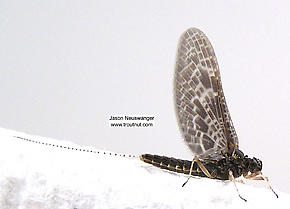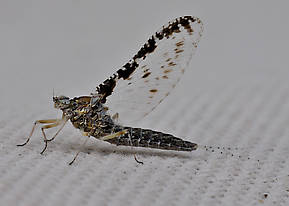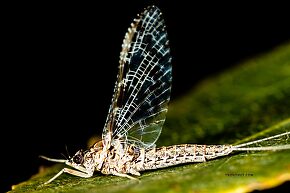Blog & Latest Updates
Fly Fishing Articles
Insects by Common Name


Mayfly Species Callibaetis ferrugineus (Speckled Spinner)
Taxonomic Navigation -?-
Kingdom
Animalia (Animals)
» Phylum
Arthropoda (Arthropods)
» Class
Insecta (Insects)
» Order
Ephemeroptera (Mayflies)
» Family
Baetidae (Blue-Winged Olives)
» Genus
Callibaetis (Speckled Spinners)
» Species ferrugineus (Speckled Spinner)
Common Names
| Match | Common Name |
| Speckled Spinner | |
| Speckled Dun | |
| Grizzly Quill | |
| Speckled-Winged Spinner |
Where & When
Regions: East, Midwest, West
Time Of Year (?): Early May through September
Preferred Waters: Stillwater
Altitude: Variable
Because this taxon is the combination of what were once thought to be a variety of different species, previously published hatch charts are unreliable unless they are related to a particular region. Different books dealing with one synonym (Synonym: A former name of a taxon, usually a species. Entomologists frequently discover that two insects originally described as different species are one in the same, and they drop one of the names. The dropped name is said to be a synonym of the remaining name. These changes take a while to trickle into the common knowledge of anglers; for example, Baetis vagans is now a synonym of Baetis tricaudatus.) or another give a variety of different dates, colors, and sizes, basically showing that this species may be found through most of the season and in a variety of configurations. It usually produces two broods but can produce three in regions of the West with a longer growing season, and the angler should consult local hatch charts for their peak times and other relevant information.Time Of Year (?): Early May through September
Preferred Waters: Stillwater
Altitude: Variable
Hatching Behavior
Time Of Day (?): Periods of calm, usually mid morning
Habitat: Littoral zones of lakes and ponds or very slow weedy margins of rivers and streams
See Hatching Behavior on the Callibaetis genus hatch page for pertinent information.Habitat: Littoral zones of lakes and ponds or very slow weedy margins of rivers and streams
Spinner Behavior
Time Of Day: Mid-morning or mid-evening
See Spinner Behavior on the Callibaetis genus hatch page for pertinent information.Nymph Biology
Current Speed: Slow
Substrate: Vegetation, silt
Environmental Tolerance: Does well in cold water
See Nymph Biology on the Callibaetis genus hatch page for pertinent information.Substrate: Vegetation, silt
Environmental Tolerance: Does well in cold water
Pictures of 4 Mayfly Specimens in the Species Callibaetis ferrugineus:
Female Callibaetis ferrugineus (Speckled Spinner) Mayfly Dun View 3 Pictures
View 3 Pictures
 View 3 Pictures
View 3 PicturesCollected July 14, 2004 from unknown in Wisconsin
Added to Troutnut.com by Troutnut on January 25, 2006
Added to Troutnut.com by Troutnut on January 25, 2006
Callibaetis ferrugineus (Speckled Spinner) Mayfly Adult View 3 PicturesThese adults are probably C. ferrugineus.
View 3 PicturesThese adults are probably C. ferrugineus.
 View 3 PicturesThese adults are probably C. ferrugineus.
View 3 PicturesThese adults are probably C. ferrugineus.Collected August 13, 2009 from the Flathead River-lower in Montana
Added to Troutnut.com by Bnewell on June 27, 2011
Added to Troutnut.com by Bnewell on June 27, 2011
Female Callibaetis ferrugineus (Speckled Spinner) Mayfly Spinner View 9 Pictures
View 9 Pictures
 View 9 Pictures
View 9 PicturesCollected September 4, 2020 from Silver Creek in Idaho
Added to Troutnut.com by Troutnut on September 18, 2020
Added to Troutnut.com by Troutnut on September 18, 2020
Recent Discussions of Callibaetis ferrugineus
Callibaetis Spinner Habits 8 Replies »
Posted by WildcatRob on Sep 8, 2007
Last reply on Jan 7, 2009 by Dgracia
With almost 40 years lake fishing experience in the Northwest (Washington) our callibaetis always seem to start hatching mid afternoon in the evening, mate overnight then the spinners start in the morning. The spinners draw the most intense "rise." I put rise in quotes because it is so delicate there it leaves almost no disturbance at all not even a sip.
Any comments? Hopefully contradictions?
Rob
ReplyAny comments? Hopefully contradictions?
Rob
Your Thoughts On Callibaetis ferrugineus:
Top 10 Fly Hatches
Top Gift Shop Designs
Eat mayflies.
Top Insect Specimens
Miscellaneous Sites
Troutnut.com is copyright © 2004-2024 Jason
Neuswanger (email Jason). See my FAQ for information about use of my images.
 privacy policy
privacy policy
